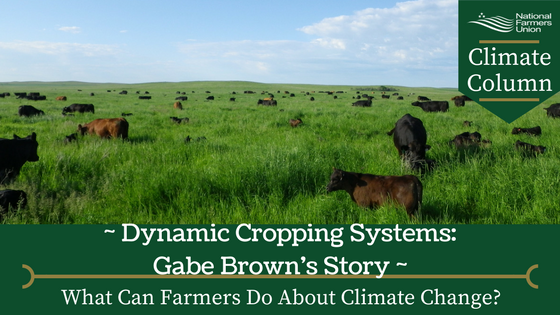 By Laura Lengnick, founder of Cultivating Resilience, LLC
By Laura Lengnick, founder of Cultivating Resilience, LLC
This story is excerpted from Resilient Agriculture: Cultivating Food Systems for a Changing Climate (New Society Publishers, 2015). Resilient Agriculture explores climate risk, resilience, and the future of food through the adaptation stories of 25 award-winning sustainable farmers and ranchers growing fruits, vegetables, nuts, grains, and livestock across America.
Gabe Brown has been producing cattle, feed, and food grains near Bismarck, North Dakota, for more than thirty years. When he began farming, natural resource quality on his ranch was poor. The cropland had been intensively tilled for many years, depleting the soil of organic matter and causing surface runoff and soil erosion. Weeds, insects, low soil moisture, and poor fertility seemed to be limiting crop yields, and the ranch’s extensive native grasslands were in poor health too. Soil organic matter levels were about 2% and infiltration capacity was a very low ½ in/hour.
With a focus on building soil quality, Gabe adopted management intensive grazing in 1991, and by 1993, he had converted all of his cropland to no-till. The following year, he began diversifying his crop rotation by adding peas to the spring wheat, oats, and barley that had been grown for many years on the ranch.
Today, the Brown Ranch includes about 2,000 acres of restored native rangeland that has never been tilled, 1,000 acres of perennial introduced forages, and another 2,000 acres of no-till, dryland cropland producing corn, peas (both grain and forage varieties), spring wheat, oats, barley, sunflowers, vetch, triticale, rye and alfalfa, plus a great diversity of cover crops. Throughout the year, as many as seventy different species are cultivated as crops. The grains, sunflower seeds, peas, and alfalfa are sold for cash, while cattle, poultry, and sheep are rotationally grazed through the grasslands, cover crops, and forages.
 Soil organic matter levels on the ranch have more than doubled – averaging 5 percent – and infiltration capacity has increased by 16 times – averaging 8 in/hr. Brown has used neither insecticides or fungicides for over a decade, nor synthetic fertilizer since 2008, and he has cut herbicide use on the ranch by 75 percent. Corn yields at Brown’s Ranch are 20 percent higher than the county average.
Soil organic matter levels on the ranch have more than doubled – averaging 5 percent – and infiltration capacity has increased by 16 times – averaging 8 in/hr. Brown has used neither insecticides or fungicides for over a decade, nor synthetic fertilizer since 2008, and he has cut herbicide use on the ranch by 75 percent. Corn yields at Brown’s Ranch are 20 percent higher than the county average.
Gabe says he noticed the weather becoming more extreme starting around 2006 or 2007, as flooding in some parts of North Dakota began to be the norm rather than a rare event. More variable weather has also complicated fieldwork, making crop production more difficult. “It used to be we knew we had a window of time when it’s usually dry and we can harvest some forages or plant a crop,” says Gabe. “We could plan for harvest during that dry period and plant crops according to a plan. That’s no longer the case.”
Gabe says the most effective climate risk management tool he has is the capacity of the ranch’s healthy soils to buffer more variable rainfall and temperatures. “If you can improve your soil resource and make these soils more resilient,” says Gabe, “you’ll be able to weather these extremes in moisture and temperature much more easily. I can easily go through a two-year drought and it does not affect our operation to any great extent because the soil is so much more resilient.”
Gabe appreciates the flexibility his diverse crop rotation allows him in variable weather conditions. Because he plants throughout the year, he can make adjustments to fine-tune the crop rotation plan to current weather conditions. “That’s the beauty of the diverse system of ours,” Gabe explains. “At times, we want to plant the cover crop. And then if the weather conditions change, maybe it’s dry, we’ll change the mix of that species a bit for more crop types that can handle drier conditions or vice versa. We have a really big toolbox to choose from.”
Swtiching out crops gives Gabe more freedom than less diverse producers to adapt his crop rotation to weather variability and extremes. This point is not lost on the conventional producers that visit the Brown Ranch to see for themselves how Gabe’s farming system works. Gabe explains, “I tell people this when I speak in the Corn Belt – those guys plant either corn or soybeans — that’s all they plant. If corn and beans don’t work out for those guys, then they’re going to have a poor year, whereas we have the ability to switch in or out of so many different crops. It just makes management so much easier.”
Like what you’ve read? Check out our Climate Leaders home page, join the conversation in the NFU Climate Leaders Facebook Group, and keep up-to-date with NFU climate action by signing up for the mailing list.